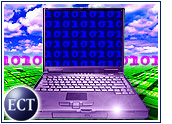Intel Corp. (Nasdaq NM: INTC), half of the so-called “Wintel duopoly” that rules the global personal computer market, inched a step closer to making personal computers obsolete by introducung its first Internet appliance Thursday.
Intel’s new Dot.Station is a counter-top terminal that enables users to surf the Web, send and receive e-mail or make phone calls. It comes with a hard drive so owners can run computer applications and store data. The screen is smaller than standard PC screens, but larger than some other existing Internet appliances, such as mobile phones or digital assistants.
The company did not say how much the device will cost, but acknowledged the manufacturing price is around $500 (US$). The Dot.Station will not be sold in retail stores, but rather as part of overall service packages by commercial interests such as Internet Service Providers, telecommunications companies, Web portals and banks.
Crowded Field
The field of Internet appliances is in its infancy, but already crowded. Though analysts have predicted a glowing future, no one company has come up with a breakthrough device to capture the public’s imagination.
There are already such non-PC Internet connection instruments as PlayStation 2, AOLTV, WebTV and Palm VII. “People will look back at today’s PCs, advanced as they are, and see them as clunky machines,” Microsoft’s Bill Gates said at a recent conference. “Things like boot-up time, people will wonder what that was all about.”
Intel’s new machine will be powered by the Linux operating system, a rival of Microsoft’s Windows.
How Fast Will Change Come?
Intel is the world’s biggest semiconductor maker, but like Microsoft, recognizes the Internet appliance era will profoundly affect the PC.
“It’s not unreasonable to guess that this is a billion-dollar business opportunity,” Intel spokesman Greg Welch told Reuters. “The question is will that come in two years, three years, four years.”
The company said the new appliance is targeted toward non-PC homes. Recent studies have shown about 60 percent of U.S. homes have at least one PC.
“I don’t see it cutting into the PC business,” Welch said. “Quite frankly, it would be my expectation that if consumers use our device and become comfortable with it… they might find a need for a PC in their lives sooner than they would have if they had never bought the device.”
Mixed Reaction
Reaction to the Intel device has thus far been mixed. Analysts point out that the cost will be roughly equivalent to low-end PCs, which offer larger screens. Many of the cheaper PCs are sold for virtually nothing — and sometimes given away for free — when combined with subsidy service contracts.
Analysts also point out that Intel has a cozy relationship with some of the larger telecommunications companies, which could offer the device with various service packages.
The Dot.Station will be offered first to European customers in the third quarter of this year. Though Intel is designing the device, it will be manufactured in Taiwan.









































Social Media
See all Social Media